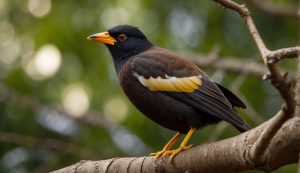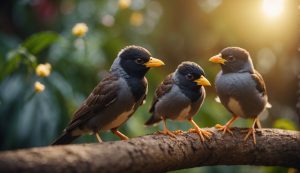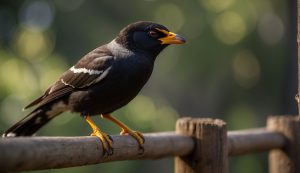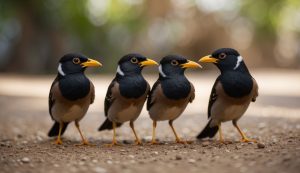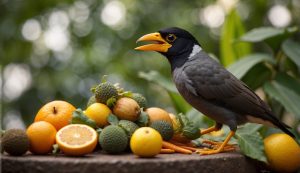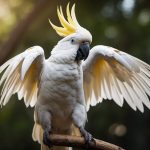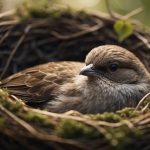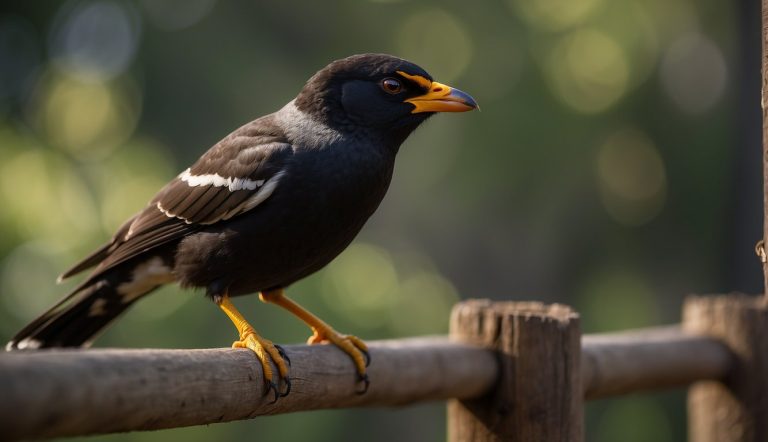How Much is a Mynah Bird? Your Guide to Costs and Care Essentials

Mynah birds are among the most fascinating avian pets you can welcome into your home. They are known for their extraordinary ability to mimic human speech.
With sleek feathers and bold personalities, these birds capture the attention of bird enthusiasts around the globe.
Deciding to get a mynah bird involves considering several aspects. One of the first questions potential mynah bird owners ask is how much one of these charming birds might cost.
The price can vary widely depending on factors such as the species of mynah bird, where it’s purchased, and whether it comes with a cage and accessories.
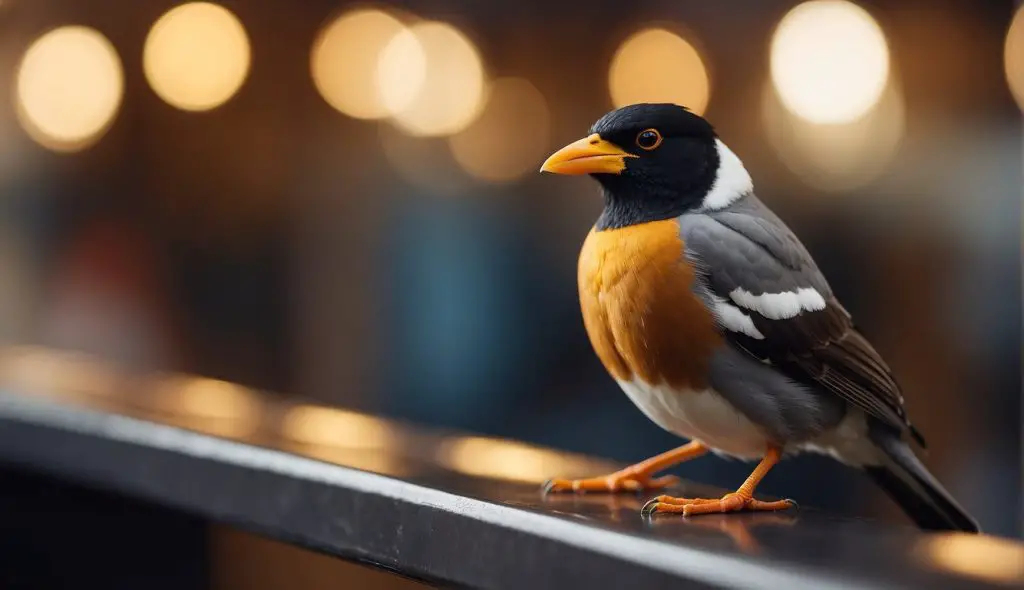
Before taking home a mynah bird, I learned it’s essential to delve into their care needs.
Mynah birds require a specific diet, plenty of space for exercise, and social interaction to thrive. They’re also known for their vocal abilities and can develop an impressive vocabulary with the right training and socialization.
However, owning a mynah bird doesn’t just come with responsibilities. These intelligent creatures can form strong bonds with their owners and provide companionship that’s both entertaining and rewarding.
Key Points
- Mynah birds are captivating pets that can mimic human speech.
- Costs for mynah birds can vary and are influenced by species, source, and additional items like cages.
- Proper care, including diet, space, and socialization, is crucial for a mynah bird’s well-being.
Table of Contents
Identifying Mynah Birds
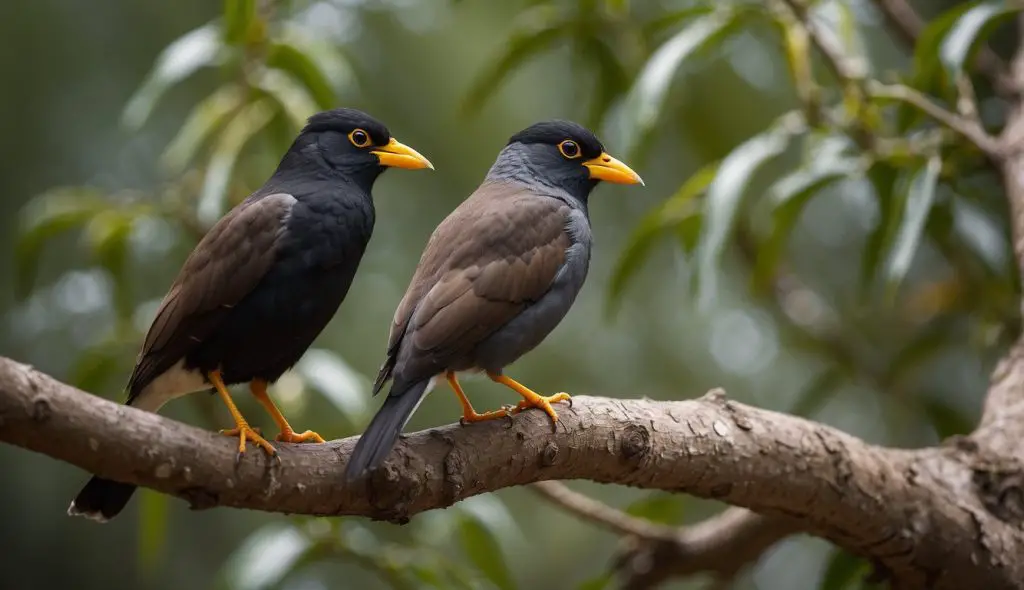
When I spot a mynah bird, there are a few telltale features I look for. These birds are known for their striking appearance and remarkable vocal abilities.
Physical Characteristics
Mynah birds are easily recognized by their bold plumage, typically featuring a combination of glossy black feathers, a bright orange-reddish beak, and matching eye patches. Their bodies are stocky with strong legs, and they have a distinctive yellow skin patch behind the eyes. I observe the following traits:
- Size: They usually measure about 23 cm (9 inches) in length.
- Tail: The tail is short and typically features a white undertip or is completely white.
- Eyes: A common myna has brown eyes, while the hill mynah often has a lighter, almost orange or yellow hue.
- Feathers: Generally, a smooth and glossy appearance, sometimes with a purple or blue iridescent sheen.
Species Variety
I know the mynah family includes several species, but two are particularly well-known:
- Common Myna (Acridotheres tristis): This species has a brown body with a black head, and it’s renowned for adapting well to urban environments.
- Hill Mynah (Gracula religiosa): Hill mynahs are renowned for their ability to mimic human speech and are often more sought after as pets. They have a darker, more lustrous black coloration and a white vent and wing patches, which make them quite distinct.
These are some of the features that I look for when identifying a mynah bird. Each species has its unique traits, but these characteristics are good starting points.
Mynah Birds as Pets
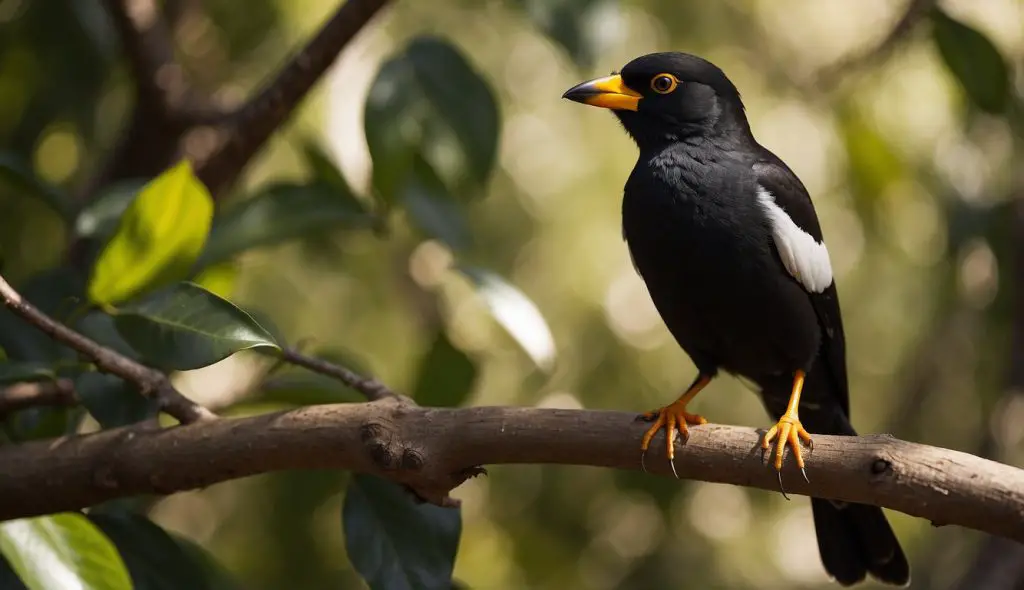
In my experience with mynah birds, I’ve learned that they can make delightful pets when their specific needs are met. Their care requires a good understanding of habitat and social interactions.
Cage Requirements
The cage for a mynah bird should be as large as practical. I prefer to use a cage that’s at least 2 feet deep by 3 feet wide by 2 feet high, giving my pet ample room to move around. An even larger cage is better, as mynahs are active birds that love to climb and play. Here’s a simple checklist I follow for my mynah bird’s cage essentials:
- Size and Bar Spacing: At least 2x3x2 feet, with bar spacing no more than 5/8-inch apart.
- Perches: Multiple perches of different diameters to exercise feet.
- Toys: Items like mirrors, bells, and puzzling toys to stimulate the bird’s intellect.
- Baths: A shallow dish for bathing, as mynahs enjoy regular baths.
Remember that a mynah bird’s cage is their kingdom – it should be spacious and enriching.
Social and Behavioral Aspects
Mynah birds are incredibly social creatures that thrive on interaction. If I’m not home often, I’ve found that keeping a pair of mynahs can prevent loneliness, since they can keep each other company.
When I interact with mynas, I ensure it’s a positive experience filled with social play and occasional treats, which helps in nurturing a trusting relationship.
Toys and interaction are crucial for my mynahs. They adore shiny objects and things that make noise, but I make sure the toys are safe and free from toxic materials.
One fascinating thing about mynah birds is their ability to mimic sounds, and I take time to talk to them regularly. They seem to love and respond to this by imitating words or whistles.
Mynah Bird Care

In my experience, two crucial elements of mynah bird care are providing a well-balanced diet and understanding their health to extend their lifespan as much as possible.
Feeding and Nutrition
I always emphasize the importance of a varied diet for my mynah birds, ensuring they receive all the nutrients they need. Mynah birds thrive on a diet that includes:
- Pellets: These should be low-iron formulas, specifically designed for mynah birds to prevent hemochromatosis, commonly known as iron storage disease.
- Fruits: Offering them a selection of fruits such as papaya, banana, and apples is part of a healthy diet; however, I avoid giving them too much as fruits high in sugar can lead to obesity. Here’s a simple list of fruits to include and to avoid: Include Avoid Apples Avocado Bananas Grapes Papaya Cherries Mango
- Insects: I also supplement my birds’ diet with insects like mealworms to replicate their natural feeding habits and provide a protein boost.
To ensure proper nutrition, I monitor the quantity and variety of food they consume, especially for young mynahs during their growth phase, to support their development.
Health and Lifespan
I’ve learned that vigilance in spotting early signs of health issues like liver problems is key to managing my mynah birds’ wellbeing. Regularly scheduled check-ups with an avian vet can help detect and manage problems early.
A common health condition I watch out for in mynah birds is hemochromatosis — heavy iron storage in their organs — so I keep a close eye on their iron intake.
A mynah bird’s lifespan typically ranges, and with good care and attention to their nutrition and health, many live longer than their average expectancy. Proper care since they’re young can definitely contribute to a healthy and lengthy lifespan. Mynah birds are social creatures, and their environment and the attention I provide significantly impact their mental and physical health.
Mynah Bird Communication Skills
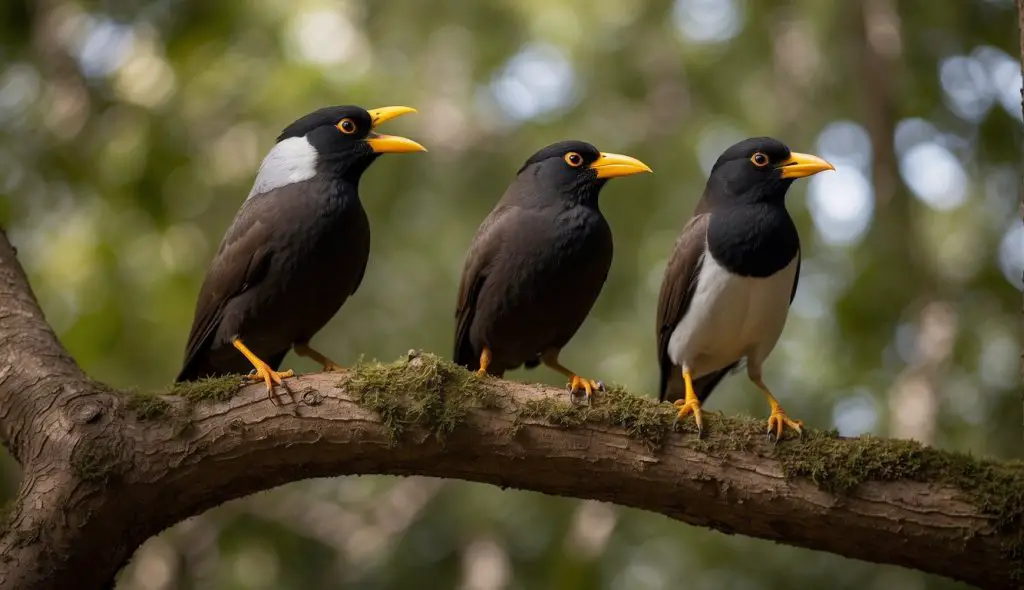
As a mynah bird enthusiast, I’ve always been amazed at their exceptional communication skills. Mynah birds, particularly the Indian Hill mynahs, are renowned for their ability to mimic human speech with remarkable clarity.
These birds have a natural gift for replicating the sounds they hear, which makes them fascinating to listen to and interact with.
When we talk about their ability to engage in a dialogue, it might not be an actual conversation as humans would have, but these intelligent birds can produce sounds that closely resemble human language. Their vocal behavior is not just mimicking for the sake of it — they sometimes seem to understand the context of words and can use them appropriately.
Training a mynah bird requires patience and consistency. Here’s a brief guide:
- Start simple: Begin with words that are easy to pronounce.
- Be patient: Repetition is key. Say the word or phrase consistently around your bird.
- Use positive reinforcement: Reward your bird when it successfully mimics a sound or word.
- Up the ante: Once your mynah masters a word, introduce new words or short phrases.
I’ve trained my mynah using these steps, and I can say that with the right approach, these birds’ skills in imitating sounds can be honed quite effectively. The success in training also highlights their intelligence and social nature, as they often use this mimicry to interact with their human companions or other mynah birds. The rewarding experience of hearing my feathered friend repeat words and phrases reassures me that the bond we share is truly special.
Purchasing and Legal Considerations

When considering adding a mynah bird to your life, it’s important for me to be mindful of the cost implications and to ensure all legal requirements, particularly for protected species like the Bali Myna, are met.
Acquiring a Mynah Bird
Purchasing a Mynah bird isn’t as straightforward as picking up a common pet. Depending on the species, one might find significant variation in price.
From pet stores to breeders, each offers a different experience.
For example, Indian Hill Mynahs might fetch a higher price at breeders due to their talking abilities, while species like the Javan Myna, viewed as common elsewhere, might be more affordable.
- Bali Myna: Rare and protected, hence more costly.
- Indian Hill Myna: Prized for mimicry, leading to a higher price tag.
Here’s a snapshot of potential costs from my research:
| Species | Cost Range at a Breeder or Pet Store |
|---|---|
| Common Myna | $100 – $500 |
| Indian Hill Myna | $500 – $2,000 |
| Bali Myna (rare) | Prices can be significantly higher, especially if the bird is legally acquired and part of a conservation program. |
Regulations and Protection
I need to emphasize that the legal landscape surrounding the trade of Mynah birds, especially protected ones like the Bali Myna, is complex and varies by location.
Protected species are often subject to international laws, such as CITES (Convention on International Trade in Endangered Species), influencing their availability and legality for trade.
It’s my responsibility to research and comply with these laws to prevent inadvertently contributing to the illegal wildlife trade. Additionally, I should:
- Verify if the species is protected or endangered.
- Acquire permits if required.
- Purchase only from licensed breeders or stores that follow ethical practices.
It’s crucial to note that laws change and may vary significantly by country or even within regions of the same country. So, I always advise checking the latest regulations before making any decisions.
Frequently Asked Questions
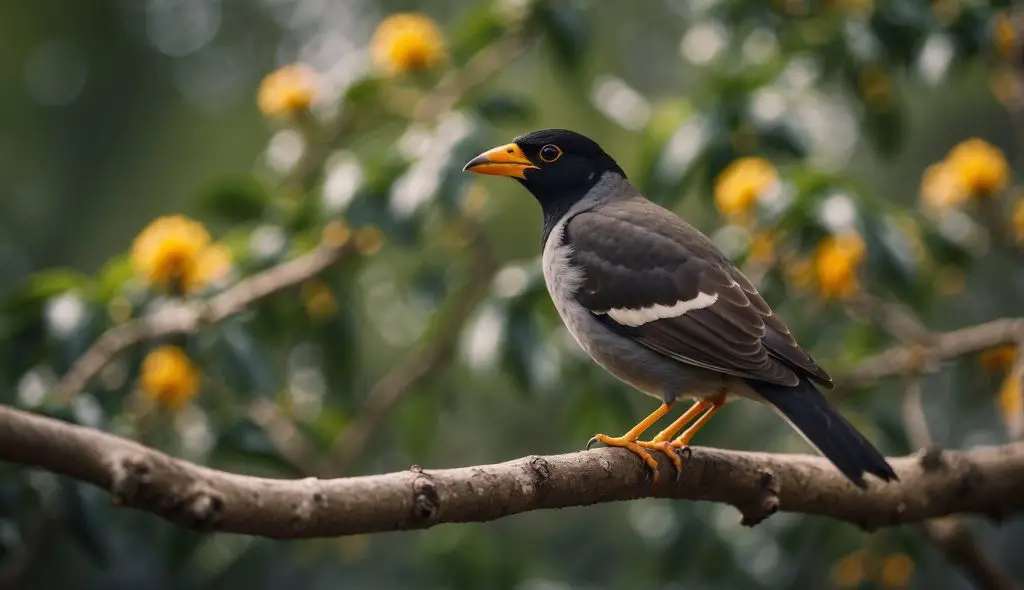
I get a lot of questions about mynah birds, so I’ve compiled some of the most common ones to help you understand these fascinating birds better.
What types of food are suitable for a mynah bird’s diet?
In my experience, mynah birds thrive on a varied diet that includes fruits, vegetables, insects, and commercially prepared mynah bird food that’s rich in protein.
What are the legal considerations for keeping a mynah bird as a pet?
Remember to check local and national regulations, as some areas may require permits to keep mynah birds, or they might be prohibited as pets altogether.
Can mynah birds be suitable and friendly pets for families?
Yes, from what I’ve seen, mynah birds can be very sociable and interactive, which makes them delightful pets for families as long as they’re properly socialized and cared for.
What’s the typical lifespan of a mynah bird in captivity?
A mynah bird in captivity, when provided with proper care and a suitable environment, typically lives for about 12 to 25 years.
What should someone look for when searching for a mynah bird for sale?
When looking for a mynah bird, I advise checking for clear eyes, clean feathers, and active behavior as signs of a healthy bird. Remember to buy from reputable sources.
How can one ensure they are buying a healthy mynah bird from a breeder?
When I buy from breeders, I always ensure they practice ethical breeding. I also make sure they provide health records and allow a visit to see the birds in person.
This helps in assessing the overall health and conditions in which the birds are kept.

